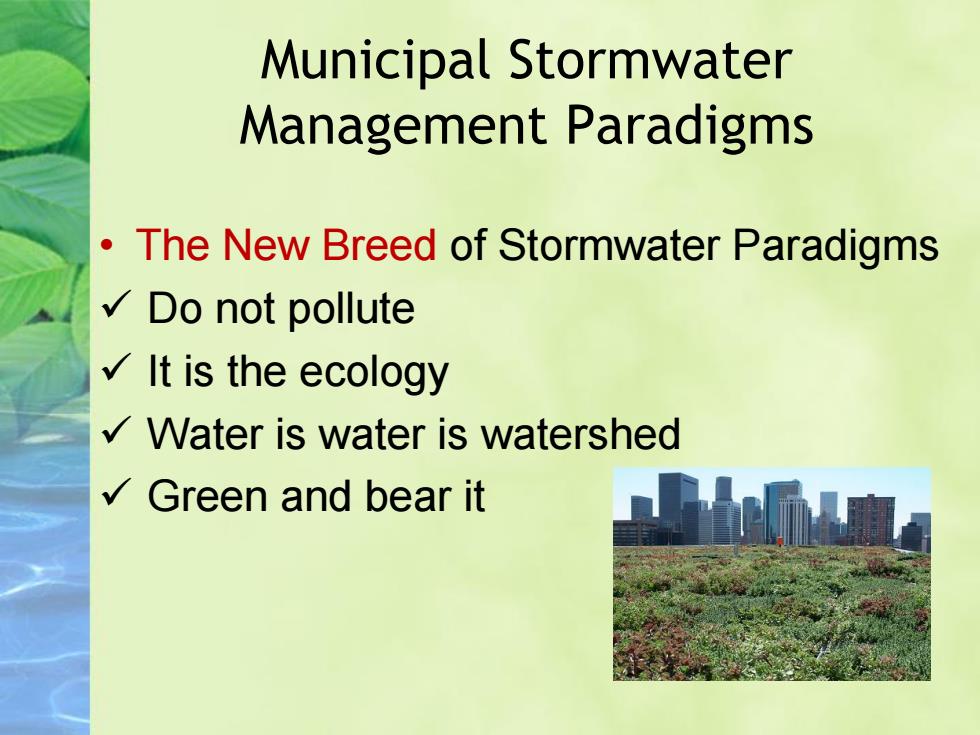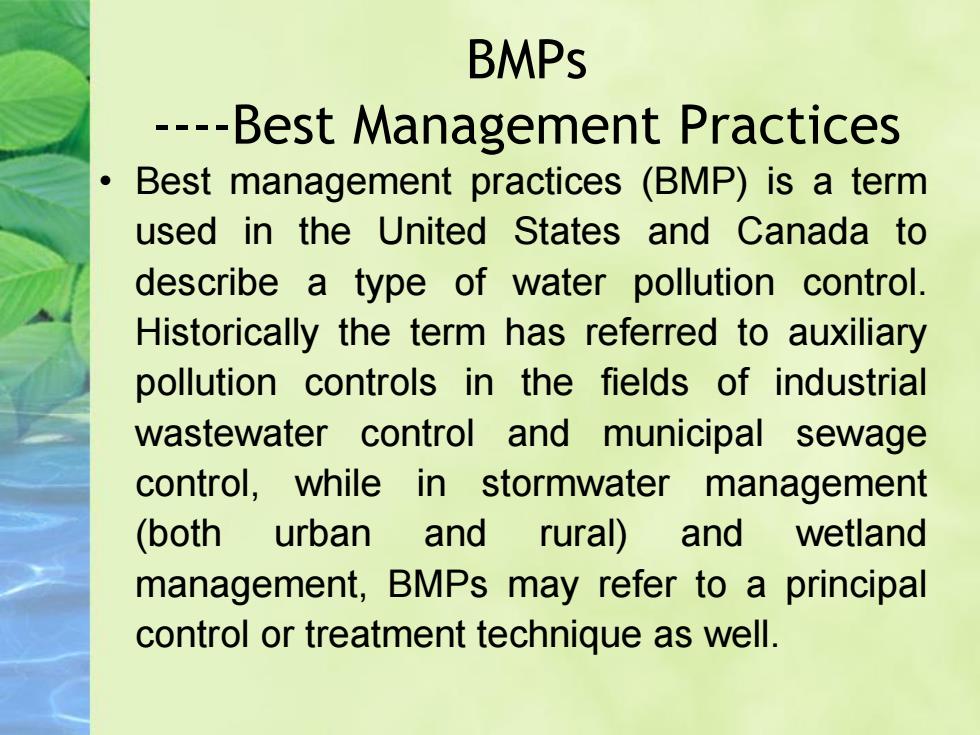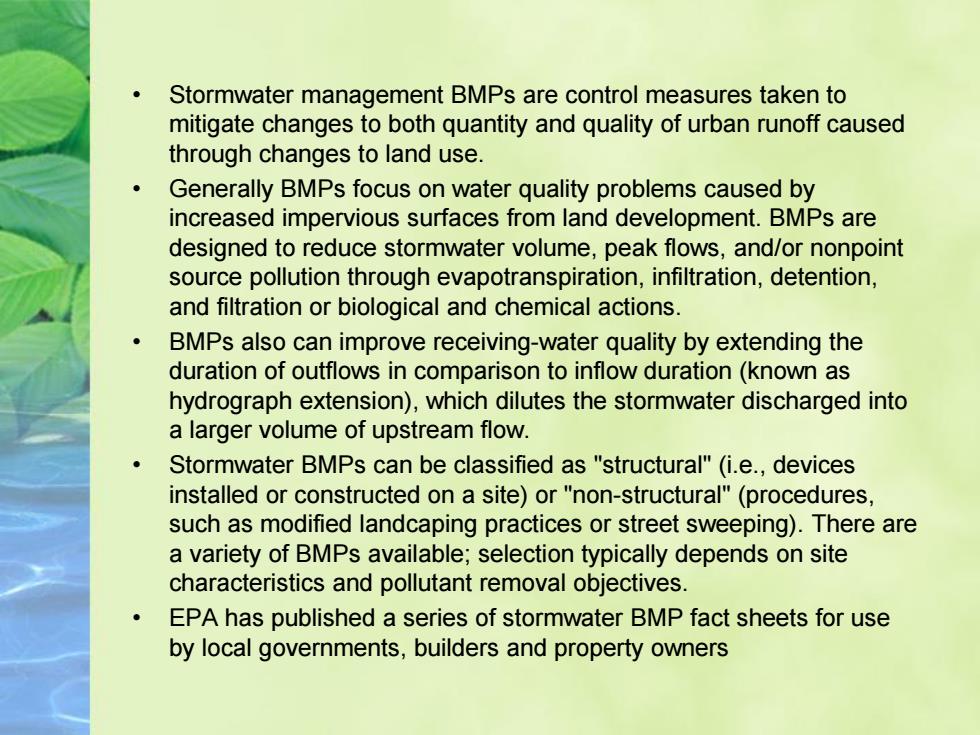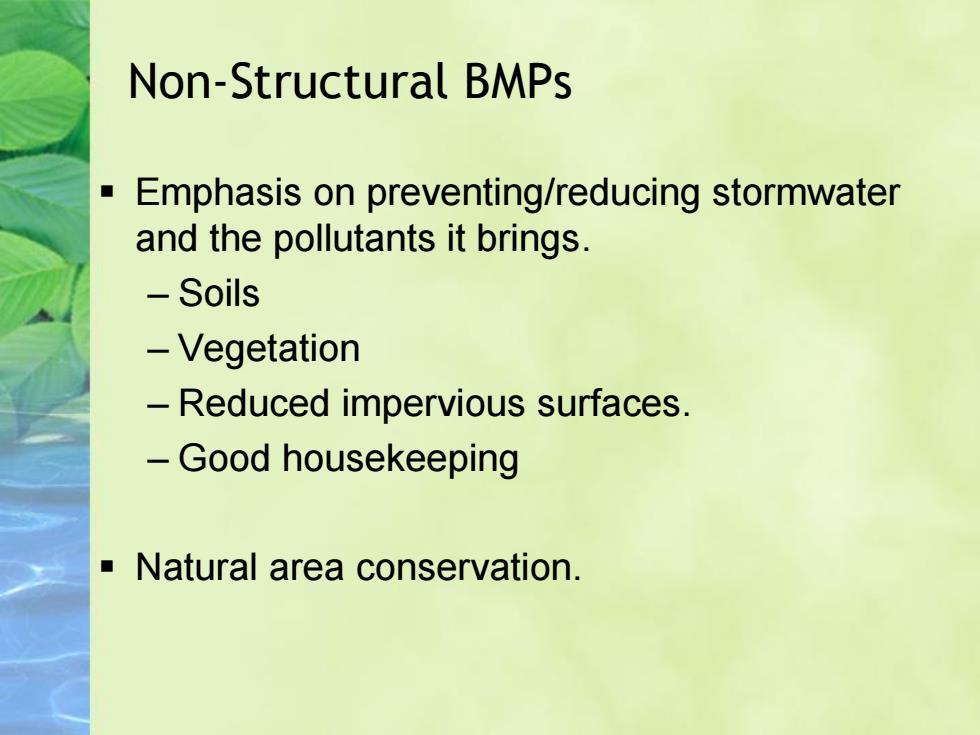
Municipal Stormwater Management Paradigms The New Breed of Stormwater Paradigms √Do not pollute √It is the ecology Water is water is watershed √Green and bear it
Municipal Stormwater Management Paradigms • The New Breed of Stormwater Paradigms ✓ Do not pollute ✓ It is the ecology ✓ Water is water is watershed ✓ Green and bear it

The history and evolution of concerned terms Best management practices(BMPs) Schueler,T.R.,1987.Controlling urban runoff:A practical manual for planning and designing urban BMPs.Washing-ton:Washington Metropolitan Water Resources Planning Board. ● low impact development(LID) Department of Environmental Resources,1999.Low-impact development:an integrated design approach.Maryland,USA:Department of Environmental Resources,Prince George's County. Sustainable urban drainage systems(SUDS) CIRIA,2000.Sustainable urban drainage systems-design manual for Scotland and Northern Ireland.Dundee,Scotland:CIRIA Report No.C521 Water sensitive urban design(WSUD) Whelans,C.,Maunsell,H.G.,and Thompson,P.,1994.Planning and management guidelines for water sensitive urban(residential)design.Perth,Western Australia: Department of Planning and Urban Development of Western Australia. Wong,T.H.F.,2007.Water sensitive urban design;the journey thus far.Australian Journal of Water Resources,110(3),213-222
The history and evolution of concerned terms • Best management practices (BMPs) • Schueler, T.R., 1987. Controlling urban runoff: A practical manual for planning and designing urban BMPs. Washing-ton: Washington Metropolitan Water Resources Planning Board. • low impact development (LID) • Department of Environmental Resources, 1999. Low-impact development: an integrated design approach. Maryland, USA: Department of Environmental Resources, Prince George’s County. • Sustainable urban drainage systems (SUDS) • CIRIA, 2000. Sustainable urban drainage systems – design manual for Scotland and Northern Ireland. Dundee, Scotland: CIRIA Report No. C521. • Water sensitive urban design (WSUD) • Whelans, C., Maunsell, H.G., and Thompson, P., 1994. Planning and management guidelines for water sensitive urban (residential) design. Perth, Western Australia: Department of Planning and Urban Development of Western Australia. • Wong, T.H.F., 2007. Water sensitive urban design; the journey thus far. Australian Journal of Water Resources, 110 (3), 213–222

BMPs ----Best Management Practices Best management practices (BMP)is a term used in the United States and Canada to describe a type of water pollution control. Historically the term has referred to auxiliary pollution controls in the fields of industrial wastewater control and municipal sewage control,while in stormwater management (both urban and rural)and wetland management,BMPs may refer to a principal control or treatment technique as well
BMPs ----Best Management Practices • Best management practices (BMP) is a term used in the United States and Canada to describe a type of water pollution control. Historically the term has referred to auxiliary pollution controls in the fields of industrial wastewater control and municipal sewage control, while in stormwater management (both urban and rural) and wetland management, BMPs may refer to a principal control or treatment technique as well

Stormwater management BMPs are control measures taken to mitigate changes to both quantity and quality of urban runoff caused through changes to land use. Generally BMPs focus on water quality problems caused by increased impervious surfaces from land development.BMPs are designed to reduce stormwater volume,peak flows,and/or nonpoint source pollution through evapotranspiration,infiltration,detention, and filtration or biological and chemical actions. BMPs also can improve receiving-water quality by extending the duration of outflows in comparison to inflow duration(known as hydrograph extension),which dilutes the stormwater discharged into a larger volume of upstream flow. Stormwater BMPs can be classified as "structural"(i.e.,devices installed or constructed on a site)or"non-structural"(procedures, such as modified landcaping practices or street sweeping).There are a variety of BMPs available;selection typically depends on site characteristics and pollutant removal objectives. EPA has published a series of stormwater BMP fact sheets for use by local governments,builders and property owners
• Stormwater management BMPs are control measures taken to mitigate changes to both quantity and quality of urban runoff caused through changes to land use. • Generally BMPs focus on water quality problems caused by increased impervious surfaces from land development. BMPs are designed to reduce stormwater volume, peak flows, and/or nonpoint source pollution through evapotranspiration, infiltration, detention, and filtration or biological and chemical actions. • BMPs also can improve receiving-water quality by extending the duration of outflows in comparison to inflow duration (known as hydrograph extension), which dilutes the stormwater discharged into a larger volume of upstream flow. • Stormwater BMPs can be classified as "structural" (i.e., devices installed or constructed on a site) or "non-structural" (procedures, such as modified landcaping practices or street sweeping). There are a variety of BMPs available; selection typically depends on site characteristics and pollutant removal objectives. • EPA has published a series of stormwater BMP fact sheets for use by local governments, builders and property owners

Non-Structural BMPs ■ Emphasis on preventing/reducing stormwater and the pollutants it brings. -Soils Vegetation Reduced impervious surfaces. Good housekeeping Natural area conservation
Non-Structural BMPs ▪ Emphasis on preventing/reducing stormwater and the pollutants it brings. – Soils – Vegetation – Reduced impervious surfaces. – Good housekeeping ▪ Natural area conservation